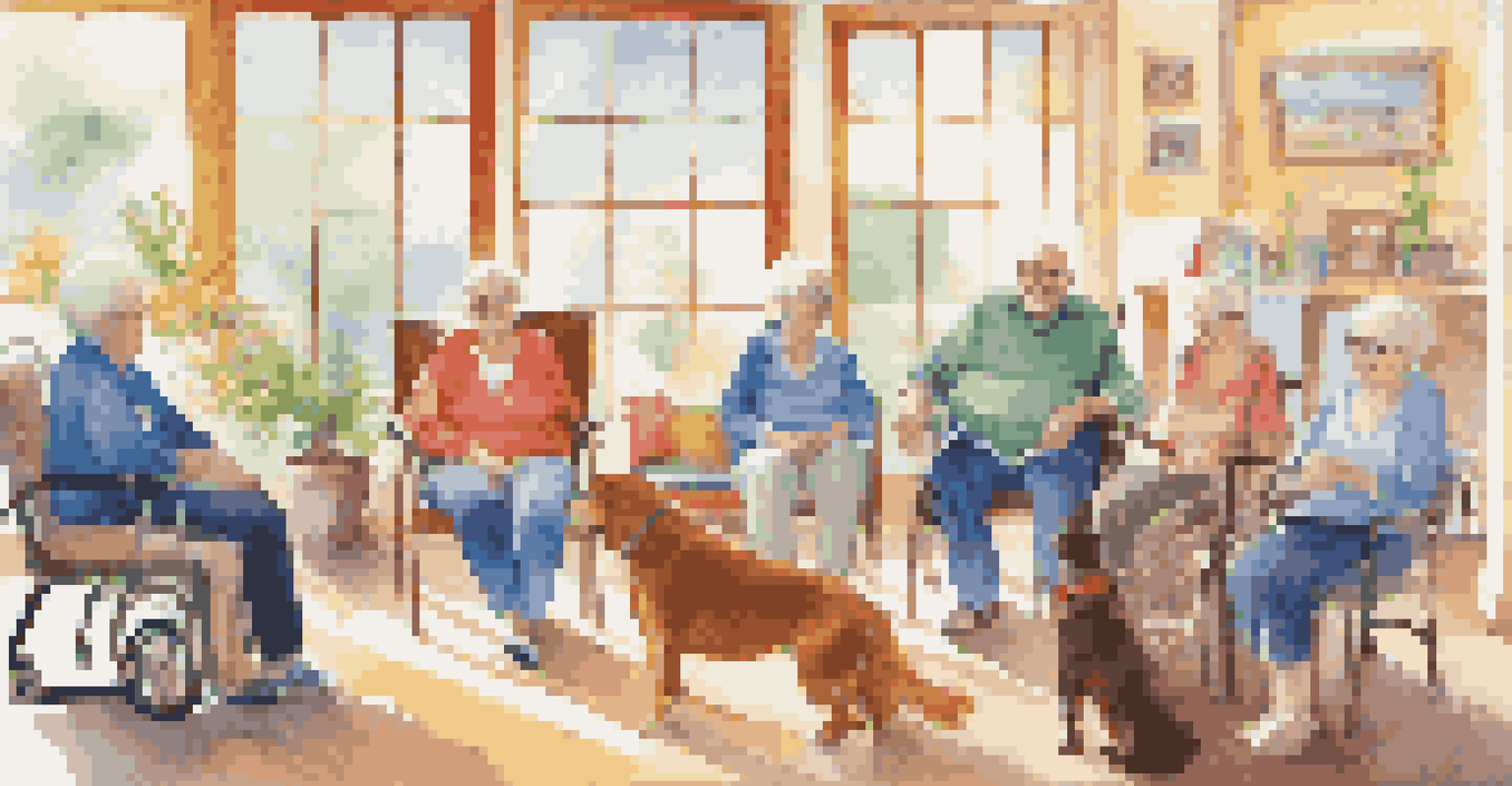Understanding the Importance of Pet Therapy for Seniors

What is Pet Therapy and Who Benefits from It?
Pet therapy involves using animals to provide comfort and support to individuals, particularly seniors. This therapeutic approach can help improve emotional and physical well-being by creating a nurturing environment. Many seniors, especially those facing loneliness or health challenges, can greatly benefit from the companionship and unconditional love animals provide.
The greatness of a nation and its moral progress can be judged by the way its animals are treated.
Research shows that interactions with pets can lead to lower stress levels, reduced anxiety, and even enhanced mood. This makes pet therapy an excellent option for older adults who might feel isolated. The presence of a furry friend can remind them of happier times or simply bring joy to their daily lives.
In essence, pet therapy not only benefits seniors but also enriches the lives of therapy animals. These animals are specially trained to interact with people, which is a fulfilling experience for them as well. It's a win-win situation that fosters connection, joy, and healing.
The Physical Benefits of Pet Therapy for Seniors
Engaging with pets can encourage physical activity, which is crucial for seniors. Whether it’s taking a dog for a walk or simply playing with a cat, these activities promote mobility and help maintain physical health. Regular movement can also improve muscle strength and coordination, reducing the risk of falls.

Additionally, studies have shown that pet therapy can lower blood pressure and heart rates in seniors. This is particularly important as cardiovascular health is a significant concern in older adults. By reducing stress and encouraging relaxation, pet therapy can contribute to overall physical well-being.
Moreover, the simple act of petting an animal can release endorphins, which are natural mood lifters. This biochemical response not only enhances physical health but also promotes a sense of calm and well-being. For seniors, these physical benefits can lead to a more active and fulfilling lifestyle.
Emotional Support Through Pet Therapy
One of the most profound impacts of pet therapy is the emotional support it provides. For many seniors, pets offer a sense of companionship that helps combat feelings of loneliness or depression. The bond formed through pet therapy can create a sense of purpose and belonging.
Until one has loved an animal, a part of one's soul remains unawakened.
Animals are great listeners and can sense when their human companions are feeling down. This instinctive ability can create a comforting presence, helping seniors feel understood and less isolated. The unconditional love offered by pets can be a powerful antidote to emotional distress.
Furthermore, interacting with pets can stimulate positive memories and feelings. For instance, reminiscing about past pets can evoke happiness and nostalgia, which can brighten a senior's day. This emotional connection is vital in maintaining mental health and overall happiness.
Social Interaction and Community Building
Pet therapy also facilitates social interaction among seniors, which is essential for mental and emotional health. Group pet therapy sessions can encourage conversation and bonding over a shared love for animals. This socialization can reduce feelings of isolation and foster a sense of community.
Seniors often find it easier to connect with others through pets, as animals serve as a common topic of interest. Whether in a nursing home or a community center, therapy animals can help break the ice and create new friendships. These social connections can enhance the quality of life for older adults.
Moreover, the presence of therapy animals can attract visitors, including family members and volunteers, promoting a lively environment. This interaction not only benefits the seniors but also enriches the lives of those visiting. Ultimately, pet therapy helps create a supportive network that uplifts everyone involved.
How Pet Therapy is Structured and Implemented
Pet therapy sessions are typically conducted by trained professionals who understand both animal behavior and the needs of seniors. These sessions are designed to be safe and comfortable, ensuring that both the animals and seniors feel at ease. The structure may include individual or group interactions, depending on the setting.
During a session, therapists may guide seniors in activities like petting, brushing, or training the animals. These activities are not only enjoyable but also promote physical interaction and engagement. The structured environment helps seniors reap the full benefits of the therapy while ensuring safety.
It's important to note that the therapy animals are carefully selected for their temperament and training. They undergo rigorous training to ensure they can handle various situations with calmness and patience. This preparation allows for effective and meaningful interactions between the animals and seniors.
Challenges and Considerations in Pet Therapy
While pet therapy offers numerous benefits, there are challenges and considerations to keep in mind. Not all seniors may feel comfortable around animals, which is why it's essential to assess their comfort levels beforehand. Individual preferences and potential allergies must be taken into account to ensure a positive experience.
Additionally, the choice of therapy animal matters. Not every animal is suited for every senior; some may respond better to dogs, while others prefer cats or even rabbits. Understanding the unique needs of each senior is crucial in facilitating successful interactions.
Moreover, ensuring the health and safety of both the seniors and the animals is vital. Regular health checks for therapy animals and maintaining a clean environment can prevent any potential issues. By addressing these challenges, pet therapy can be a safe and rewarding experience for everyone involved.
Real-Life Success Stories of Pet Therapy
There are countless heartwarming stories that showcase the positive effects of pet therapy on seniors. For instance, a resident at a nursing home who had been withdrawn and silent began to open up after interacting with a therapy dog. The companionship provided by the dog brought joy back into her life, and she started participating in group activities again.
Another inspiring story involves a war veteran who struggled with PTSD. After engaging in regular pet therapy sessions with a trained service dog, he reported significant improvements in his emotional well-being. This newfound bond not only helped him manage his feelings but also gave him a sense of purpose.

These anecdotes highlight the transformative power of pet therapy, illustrating how it can foster healing, joy, and connection. By sharing these success stories, we can encourage more seniors to explore the possibility of incorporating pet therapy into their lives.